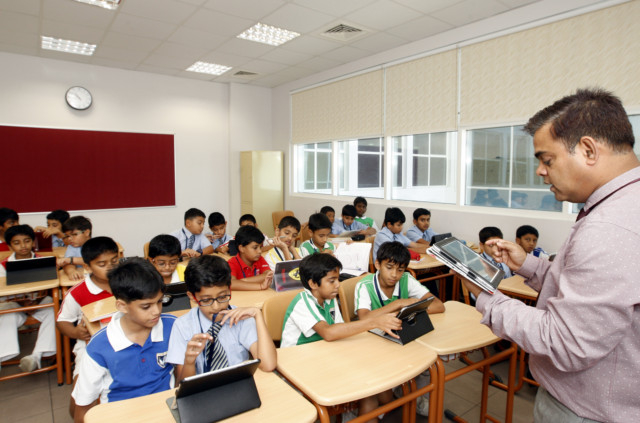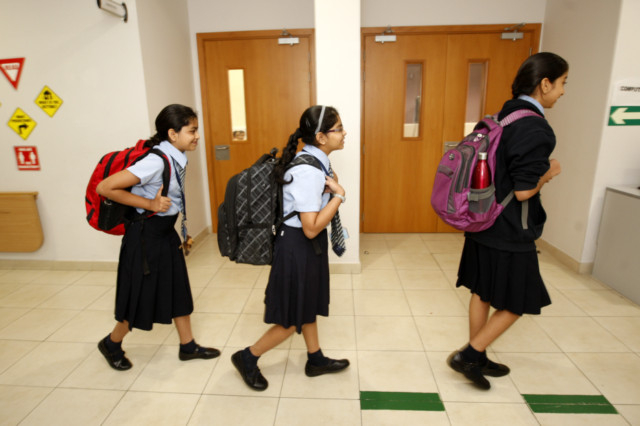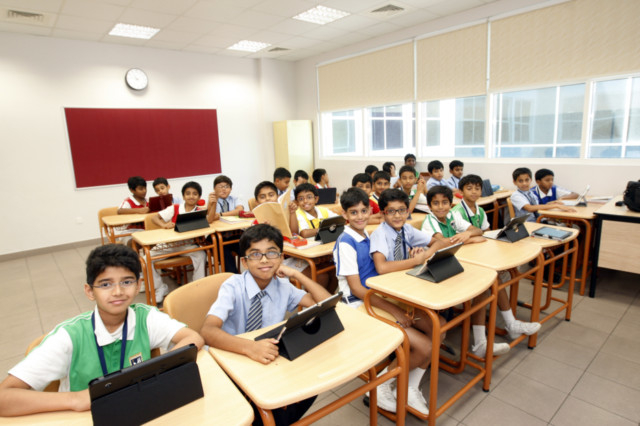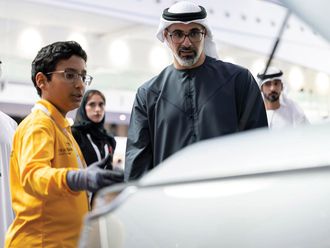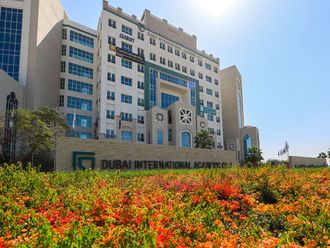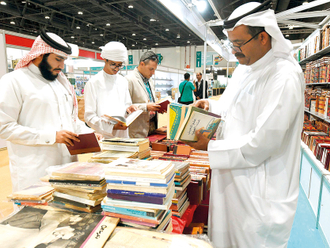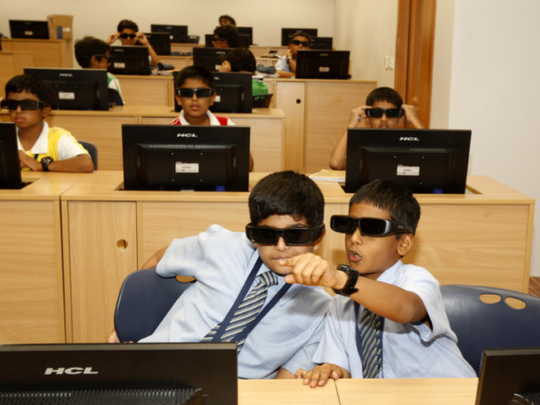
Meeting the needs of the 21st century learners head on, the Gems Modern Academy (GMA) became the first Asian school in the UAE to introduce a digital curriculum beginning this month. What does that mean for its students? Wll all learning be web-based, with online assessments, exams, lessons and homework? In a few years time, that is exactly where the school wishes to reach. For now, the programme was flagged off with the introduction of partial digital curriculum in select grades in the first phase beginning the first week of May. About 805 students of the total 952 students of grades 4, 5, 6 and 7 put together elected to participate in the Bring Your Own Device (BYOD). In a device-agnostic approach, the IT administrator of GMA, Ritesh Dhanak, the key person in implementation of the programme, made sure he used computing systems that were compatible across various systems thus facilitating the use of personal laptops without a hitch.
One reason for this great leap forward is, of course, to keep in step with the preferences of the digital natives who prefer to learn in a more non-traditional manner. But an immediate other reason was the health of the students staggering under the weight of their school bags. Says Darryl Bloud, principal of GMA, “Every morning, when I stand at the entrance in the bus parking area with my vice principal, I see children struggling with their heavy bags. When I personally pick up some of the school bags, I wonder how these children manage to carry that weight back and forth – this is something parents have been worrying me about for some years now. The thought of reducing the burden for the children was uppermost on our minds and when my Senior Leadership Team brainstormed, they came up with the idea of putting the curriculum framework on a tablet. The seed was sown.”
Digitisation, says Bloud, is here to stay. In the run-up to the big shift to BYOD, there were surveys, opinions, workshops, seminars, meetings… all of which “went into the melting pot and stirred up a technology broth that bubbled on the front burner for a while before we took the plunge,” says Bloud.
“As a school that is committed to ensuring that our children get the best possible education, we feel that this is the way forward. The 21st century students are a breed apart. They are digital natives and embrace technology wholeheartedly. The future is clearly signposted for us. This is one tiny step in that direction.”
Currently, Grades 4,5,6 and 7 have Math, Science, Hindi and French with digital curriculum. To implement this, the school first had to study their counterparts around the world that had adopted digital curriculums, locate content providers who created digital textbooks in the subjects that adhered to the ICSCE curriculum the school presently follows and to make sure the content was well layered and easily navigable. Ritesh Dhanak, the IT administrator at the school, describes the digital odyssey he and his core team of 5 undertook to make sure this dream was translated into reality.
“We intend to replace all textbooks digitally in the next two years in these grades and also extend the programme to other grades. In five years real time, textbooks will become extinct at GMA and the school hopes to have a stimulated learning programme through apps, virtual simulation of experiments, online quiz and virtual activities. In the long run, teachers of the school will create the content for digital textbooks in a manner following a structure of scaffold learning. This means, students will have richly layered content in their digital textbooks. For instance, if a student has a lesson on volcanoes, all information about volcanoes would be incorporated in it such as there would be a link on dormant volcanoes, another on live volcanoes and so on so that the student surfs the net and all linked information through the lesson. The schoolis going ahead with a systematic programme to have teachers from each grade working with their grade coordinator to create their own digital curriculum that will be reviewed by academic peers and approved by the ICSCE board.”
The scene at GMA’s 3D lab
Students of grade 7 are being taught about Specialised Cell structure through 3D content material. It takes me back to my school years when everything was inside a black and white textbook and my mind worked overtime to visualise all that I was being taught. Here, the visuals were dancing in front of the students eyes and their excitement was palpable. Class teacher Sreevidya, who followed up the 3D session with a round of questions and answers was quick to observe how the concept had gone down well with every student. “3D learning, which we have in limited subjects as of now, engages students faster,” she says. “Students today are visual learners and when they see the cell structure in a 3 –dimensional form, they are able understand and retain information faster. In the 15 years I have been teaching biology, I have never seen such fast learning. Students look forward to this class.”
She outlines the multiple benefits of online learning
• Students are most comfortable with it already and everyone we have spoken to/interacted with has been happy with the use of the tablets as textbooks. Children are enthusiastic about learning with technology and are comfortable using their devices to work independently and in collaboration without having to carry/use heavy text books.
• Slower learners can repeatedly access the virtual information anywhere and anytime if they are connected to a Wifi network. Educational apps too have been made available to the children so that they can use the tabs to read, learn and have fun while they do it. For instance students who had a tendency to write slowly have been quick on the uptake of technology and have learnt to take photo of what is being done on the class board and refer to the same later. They then have the luxury to copy down notes in their free time instead of trying to race with the rest of the class.
• It has made learning fun, interactive and more accessible at the push of a button. Teachers are able to engage the students by referring to links, websites and other resources that are easily and instantly accessible to the all the students.
Checks and balances: How students remain faithful to the topic being taught
However, there is always a downside to everything and in this case, the school had a few teething problems. One of the main issues was the reluctance of some parents to embrace technology as an integral part of their child’s education. They feared that digital learning might be superficial as textbooks seem more solid and that their child might get hooked on to tablet. Many parents also feared that their children might succumb to the temptation of straying to other sites which may lead to distracted learning.
GMA, to assuage parental fears has taken steps to ensure that learning happens in an uninterrupted fashion where the child has access to only the content on a particular subject being taght in the classroom. Ritesh throws light on the digital checks in place that ensure only good learning takes place. ”We have an effective mobile deployment management solution in place where we make sure that the student and the teacher are literally on the same page.” As soon as the students log into the school network, there is software in place that ensures that only content that is meant for that time is accessible to the students So if a science class is in progress, the student will be able to access only material related to his curriculum.”
Slowly, parents’ reluctantance is being replaced by optimism about the system and allowing their avid learners the opportunity to do what they love best – explore the real world through the virtual one.
But one more contentious issue egarding BYOD approach remains to be addressed. Does this method court elitism, limiting this privilege to only those who can afford e-learning devices? GMA defends its decision by pointing out that they have been very proactive in providing free tablets across the school at several stations where any student is free to sit down and log on and do his/her work. Besides this, they have outsourced tablets worth Dh750 each with some organisation in India. “We do not compel parents to buy these but have given them the option as this is a simple I-note pad that is compatible with our system at school and has enough features to enable the student to do his class and homework.
What about the much-discussed possibility that digital learning could make students more susceptible to plagiarism? How does the school ensure that tests and assessments are fair and transparent. Says Ritesh, “At this preliminary stage, the tablets are not being used for testing purposes. However, in the broader scheme of things, the school is looking at instituting a system of online testing. This will also significantly reduce the burden on teachers who have to correct scores of test papers each term. However, it is prudent to mention that GMA already engages pupils with the use of ‘Active Vote’ in the class room.” This is a system outside of the virtual learning world which simply facilitates students marking in class quizzes and assists in e-learning. Teachers use this technology to conduct quizzes, ask questions and as plenaries, the school also assesses every student as he or she moves into a higher grade to get an idea of their proficiency. This is called Entry Level Testing system and the admission tests are already being conducted and checked online. This ensures that a teacher has a fair idea of a student’s capability and helps the teacher check if the student is answering way beyond his capacity.
The element of cost effecitiveness is also a core aspect of the this new initiative which, the school believes, will win over all parents. Says Ritesh, “As our digital curriculum grows in quantum, we are looking at yearly reduction of the cost of textbooks. As of now, we have also been able to source tablets the children to use which are quite affordable as opposed to other tablets in the market.”
The biggest deal maker however is that online learning is an inevitability and the digital natives are more than happy to learn in a new environment. When passion and knowledge and fun are combined, it leads to a potent experience of learning that remains with you for life. Tomorrow’s education it seems is all about getting that mix right and GMA is well on its way towards that goal.


